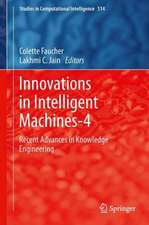Modelling Machine Emotions for Realizing Intelligence: Foundations and Applications: Smart Innovation, Systems and Technologies, cartea 01
Editat de Toyoaki Nishida, Colette Faucheren Limba Engleză Paperback – 28 iun 2012
| Toate formatele și edițiile | Preț | Express |
|---|---|---|
| Paperback (1) | 941.82 lei 6-8 săpt. | |
| Springer Berlin, Heidelberg – 28 iun 2012 | 941.82 lei 6-8 săpt. | |
| Hardback (1) | 946.55 lei 6-8 săpt. | |
| Springer Berlin, Heidelberg – 3 mai 2010 | 946.55 lei 6-8 săpt. |
Din seria Smart Innovation, Systems and Technologies
- 20%
 Preț: 601.32 lei
Preț: 601.32 lei - 18%
 Preț: 1111.97 lei
Preț: 1111.97 lei - 18%
 Preț: 1861.27 lei
Preț: 1861.27 lei - 20%
 Preț: 760.64 lei
Preț: 760.64 lei - 18%
 Preț: 1903.86 lei
Preț: 1903.86 lei - 18%
 Preț: 1236.99 lei
Preț: 1236.99 lei - 20%
 Preț: 1721.69 lei
Preț: 1721.69 lei - 20%
 Preț: 1287.78 lei
Preț: 1287.78 lei - 20%
 Preț: 1749.74 lei
Preț: 1749.74 lei - 20%
 Preț: 2221.63 lei
Preț: 2221.63 lei - 18%
 Preț: 2520.23 lei
Preț: 2520.23 lei - 20%
 Preț: 1337.27 lei
Preț: 1337.27 lei - 18%
 Preț: 1557.39 lei
Preț: 1557.39 lei - 18%
 Preț: 1123.35 lei
Preț: 1123.35 lei - 18%
 Preț: 1393.09 lei
Preț: 1393.09 lei - 20%
 Preț: 1738.54 lei
Preț: 1738.54 lei - 20%
 Preț: 2205.12 lei
Preț: 2205.12 lei - 18%
 Preț: 1226.11 lei
Preț: 1226.11 lei - 20%
 Preț: 1300.14 lei
Preț: 1300.14 lei - 20%
 Preț: 931.84 lei
Preț: 931.84 lei - 20%
 Preț: 1933.71 lei
Preț: 1933.71 lei - 20%
 Preț: 1778.85 lei
Preț: 1778.85 lei - 18%
 Preț: 1117.99 lei
Preț: 1117.99 lei - 20%
 Preț: 1759.63 lei
Preț: 1759.63 lei - 18%
 Preț: 952.09 lei
Preț: 952.09 lei - 20%
 Preț: 1762.94 lei
Preț: 1762.94 lei - 18%
 Preț: 1383.00 lei
Preț: 1383.00 lei - 20%
 Preț: 1922.18 lei
Preț: 1922.18 lei - 20%
 Preț: 1623.53 lei
Preț: 1623.53 lei - 20%
 Preț: 1623.53 lei
Preț: 1623.53 lei - 20%
 Preț: 2210.06 lei
Preț: 2210.06 lei - 20%
 Preț: 1618.60 lei
Preț: 1618.60 lei - 20%
 Preț: 1312.52 lei
Preț: 1312.52 lei - 20%
 Preț: 1310.88 lei
Preț: 1310.88 lei - 20%
 Preț: 1753.06 lei
Preț: 1753.06 lei - 20%
 Preț: 1456.88 lei
Preț: 1456.88 lei - 20%
 Preț: 1464.33 lei
Preț: 1464.33 lei - 20%
 Preț: 1627.65 lei
Preț: 1627.65 lei - 20%
 Preț: 1463.49 lei
Preț: 1463.49 lei - 20%
 Preț: 1923.82 lei
Preț: 1923.82 lei -
 Preț: 436.35 lei
Preț: 436.35 lei - 15%
 Preț: 641.71 lei
Preț: 641.71 lei - 18%
 Preț: 1413.76 lei
Preț: 1413.76 lei - 20%
 Preț: 1781.21 lei
Preț: 1781.21 lei - 20%
 Preț: 1756.37 lei
Preț: 1756.37 lei - 20%
 Preț: 1756.37 lei
Preț: 1756.37 lei - 20%
 Preț: 1634.59 lei
Preț: 1634.59 lei - 18%
 Preț: 1124.92 lei
Preț: 1124.92 lei
Preț: 941.82 lei
Preț vechi: 1148.56 lei
-18% Nou
Puncte Express: 1413
Preț estimativ în valută:
180.24€ • 187.48$ • 148.80£
180.24€ • 187.48$ • 148.80£
Carte tipărită la comandă
Livrare economică 14-28 aprilie
Preluare comenzi: 021 569.72.76
Specificații
ISBN-13: 9783642263262
ISBN-10: 3642263267
Pagini: 240
Ilustrații: X, 228 p. 96 illus.
Dimensiuni: 155 x 235 x 13 mm
Greutate: 0.34 kg
Ediția:2010
Editura: Springer Berlin, Heidelberg
Colecția Springer
Seria Smart Innovation, Systems and Technologies
Locul publicării:Berlin, Heidelberg, Germany
ISBN-10: 3642263267
Pagini: 240
Ilustrații: X, 228 p. 96 illus.
Dimensiuni: 155 x 235 x 13 mm
Greutate: 0.34 kg
Ediția:2010
Editura: Springer Berlin, Heidelberg
Colecția Springer
Seria Smart Innovation, Systems and Technologies
Locul publicării:Berlin, Heidelberg, Germany
Public țintă
ResearchCuprins
Modeling Machine Emotions for Realizing Intelligence – An Introduction –.- Automatic Affective Dynamics: An Activation–Habituation Model of Affective Assimilation and Contrast.- Judgement as to Whether or Not People Are “Involved, Enjoying and Excited,” Based on the Visual and Physiological Information.- Modelling Interaction Dynamics during Face-to-Face Interactions.- Emotional Model Based on Computational Intelligence for Partner Robots.- Facial Expression Synthesis Based on Emotion Dimensions for Affective Talking Avatar.- Attentive Conversational Agent with Internal State Transition for Multiple Users.- Integrating the Emotional Intelligence into the Virtual Technical Support Engineer.- Recognition of Fine-Grained Emotions from Text: An Approach Based on the Compositionality Principle.- Interacting with Emotion and Memory Enabled Virtual Characters and Social Robots.
Textul de pe ultima copertă
Emotion connects the thought to the body, which is a magnificent biological device for sensing and affecting the world. The thought controls the body through emotions. The body affects the thought through emotions. Through this mechanism, the thought allows the agent to behave intelligently in the complex world filled with a huge amount of dynamic information. The emotion maps a flux of information into a space which the agent is familiar with, enabling her/him to associate ongoing events with past experiences which help to reduce complexity by providing with a nominal solution.This research book aims to present recent progress in modeling and synthesizing emotional intelligence. The book consists of ten chapters. The first chapter overviews discussions in this volume. It describes major concepts and issues underlying primitive machineries, appraisal theories, primary and secondary emotions, and image-based thought processes. It discusses how emotional engines might be incorporated into an intelligent system. The nine chapters following this introductory chapter span a wide spectrum of issues concerning emotional models, ranging from a psychological model of priming timing effects to applications to emotionally intelligent agents.
Caracteristici
Latest research in the area of theory and applications of machine emotions Written by experts in the field State-of-the-art on modelling machine emotions

























